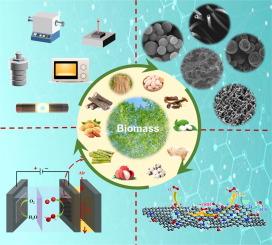Biomass-derived carbon-based catalysts for electrochemical production of hydrogen peroxide
IF 14.9
1区 化学
Q1 Energy
引用次数: 0
Abstract
H2O2 is one of the most important chemicals in the world. Recently, the electrochemical synthesis of H2O2 by two-electron oxygen reduction reaction (2e− ORR) has attracted great interest. Carbon-based catalysts show great promise for electrocatalytic production of H2O2, due to the ease of regulation of the carbon materials with regard to the pore structure, surface properties, and heteroatom doping. Biomass as the carbon precursor has the advantages of low cost, sustainable supply, and extensive availability. Conversion of biomass to functional carbon-based materials shows the attractive merits, such as low carbon emission in the life cycle and diversity of the obtained carbon materials due to the wide source of biomass feedstocks. In this article, a comprehensive review on the mechanisms and processes of electrochemical synthesis of H2O2 by 2e− ORR over carbon-based catalysts is provided. The potential biomass feedstock used for obtaining the carbon-based catalysts, and the strategies to prepare the catalysts by carbonization and heteroatom doping, as well as optimization of electrodes and design of electrolyzer, are discussed. It is recommended that future work focus on developing efficient methods to prepare the catalysts from low-cost biomass feedstock, understanding the mechanisms of 2e− ORR over the catalysts, optimization of electrode materials loaded with biomass-derived catalysts, as well as development of electrolyzers for larger-scale applications.

电化学生产过氧化氢的生物质衍生碳基催化剂
H2O2是世界上最重要的化学物质之一。近年来,双电子氧还原反应(2e - ORR)电化学合成H2O2引起了人们的广泛关注。由于碳基催化剂在孔隙结构、表面性质和杂原子掺杂方面易于调节,因此在电催化生产H2O2方面具有很大的前景。生物质作为碳前驱体具有成本低、供应可持续、可得性广等优点。将生物质转化为功能碳基材料显示出诱人的优点,例如生命周期内的低碳排放以及由于生物质原料来源广泛而获得的碳材料的多样性。本文综述了碳基催化剂上2e - ORR电化学合成H2O2的机理和过程。讨论了制备碳基催化剂的潜在生物质原料、炭化和杂原子掺杂制备碳基催化剂的策略、电极优化和电解槽设计。建议未来的工作重点是开发低成本生物质原料制备催化剂的有效方法,了解催化剂上2e - ORR的机制,优化装载生物质衍生催化剂的电极材料,以及开发用于大规模应用的电解槽。
本文章由计算机程序翻译,如有差异,请以英文原文为准。
求助全文
约1分钟内获得全文
求助全文
来源期刊

Journal of Energy Chemistry
CHEMISTRY, APPLIED-CHEMISTRY, PHYSICAL
CiteScore
19.10
自引率
8.40%
发文量
3631
审稿时长
15 days
期刊介绍:
The Journal of Energy Chemistry, the official publication of Science Press and the Dalian Institute of Chemical Physics, Chinese Academy of Sciences, serves as a platform for reporting creative research and innovative applications in energy chemistry. It mainly reports on creative researches and innovative applications of chemical conversions of fossil energy, carbon dioxide, electrochemical energy and hydrogen energy, as well as the conversions of biomass and solar energy related with chemical issues to promote academic exchanges in the field of energy chemistry and to accelerate the exploration, research and development of energy science and technologies.
This journal focuses on original research papers covering various topics within energy chemistry worldwide, including:
Optimized utilization of fossil energy
Hydrogen energy
Conversion and storage of electrochemical energy
Capture, storage, and chemical conversion of carbon dioxide
Materials and nanotechnologies for energy conversion and storage
Chemistry in biomass conversion
Chemistry in the utilization of solar energy
 求助内容:
求助内容: 应助结果提醒方式:
应助结果提醒方式:


